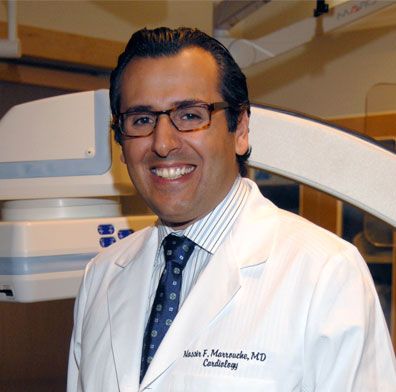Article
Catheter Ablation Lowers AFib Mortality, Hospitalization Rates
Author(s):
Catheter ablation lowered mortality rates to 13.4% and hospitalization rates to 20.7%, significant decreases compared to the conventional methods.

Patients that received catheter ablation of atrial fibrillation (AF) have lower mortality rates and less hospitalization for worsening heart failure, according to the CASTLE-AF trial results, presented at the European Society of Cardiology (ESC) Congress in Barcelona, Spain.
All-cause mortality rates with catheter ablation were 13.4% compared to 25% with conventional methods (HR 0.53; 95% CI, 0.32-0.86; p=0.011), and rates of hospitalization for heart failure were 20.7% compared to 35.9% (HR 0.56; 95% CI, 0.37-0.83; P=0.004).
The trial, led by Nassir Marrouche (pictured), MD, a professor of internal medicine at the Comprehensive Arrhythmia Research and Management Center at the University of Utah, and Johannes Brachmann, MD, from the Klinikum Coburg in Germany, examined the impact catheter ablation would have on all-cause mortality and hospitalization rates in AF patients with ventricular dysfunction when compared to conventional methods of treatment as recommended by the American Heart Association and the ESC.
“The medical community continues to debate the ideal treatment for AF in patients with left ventricular dysfunction due to the lack of clinical studies that support one definitive treatment,” Marrouche said in a statement. “Common therapies for AF include medication that regulates or slows the heart rate.”
The CASTLE-AF trial inspected 397 patients, all with implantable cardioverter defibrillators (ICD) with the ability to home monitor, and suffering symptomatic paroxysmal or persistent AF and heart failure with pump function less than 35%.
The study arms were randomly assigned either the conventional drug treatment (rhythm or rate control) or radiofrequency catheter ablation, with a primary endpoint of the composite of all-cause mortality and unplanned hospital visits for worsening heart failure.
At the median follow-up of 37.8 months, the ablation group’s rate of the primary endpoint was 28.5%, compared to the significantly higher 44.6% of the control arm (HR, 0.62; 95% CI, 0.43-0.87; p=0.007).
“We found that compared to those receiving conventional treatment, patients receiving catheter ablation were 38% less likely to experience the primary endpoint, 47% less likely to die, and 44% less likely to be hospitalized with worsening heart failure,” Marrouche said. “A significant number of patients undergoing the ablation treatment were still in normal rhythm at the end of the study.”
Marrouche admitted that the presence of already implanted ICDs may have affected mortality in both arms of the study, but that it did not overshadow the light shined on the importance of maintaining and restoring regular heart rhythm with ablation.
“Until now we had no evidence that ablation, arrhythmia medications, or any other treatment was superior to another in saving lives and reducing hospitalization,” Brachmann said in a statement. “This study has the potential to change the way physicians manage many patients suffering from heart failure and atrial fibrillation.”
Related Coverage
Extended Ticagrelor Shows Cardiovascular Risk Reduction
FDA Approves Liraglutide for Cardiovascular Risk
Heightened Risk of Hemorrhagic Stroke Linked to Methamphetamine Use



